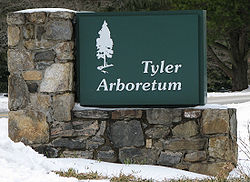Related Topics
Quakers: All Alike, All Different
Quaker doctrines emerge from the stories they tell about each other.
Nature Preservation
Nature preservation and nature destruction are different parts of an eternal process.
Touring Philadelphia's Western Regions
Philadelpia County had two hundred farms in 1950, but is now thickly settled in all directions. Western regions along the Schuylkill are still spread out somewhat; with many historic estates.
Customs, Culture and Traditions (2)
.
Gardens Flowers and Horticulture
Gardening, flowers and the Flower Show are central to the social fabric of Philadelphia.
Delaware County, Pennsylvania
.
Natural Science
foo
Right Angle Club 2011
As long as there is anything to say about Philadelphia, the Right Angle Club will search it out, and say it.
Quaker Gardens
New topic 2016-12-04 04:23:55 description
Tyler Arboretum

|
| Tyler Arboretum |
There are over thirty arboreta in the Philadelphia region, and one of the oldest and largest is located in Delaware County. The 650 acres of the Tyler Arboretum, adjoining 2500 acres of a state park, create a rather amazing wooded area quite close to heavily settled urban Philadelphia. The Arboretum is located on land directly deeded by William Penn, but it was privately held until 1940 and so is not as well known as several other arboreta of the region. The early Quakers, it may be recalled, often disapproved of music and "artwork", so their diversions tended to concentrate on various forms of natural science. The first director of the Tyler, Dr. John Wister, planted over 1500 azalea bushes as soon as he took office in the 1940s. They are now seventy or eighty years old, quite old and big enough to make an impressive display. Even flowering bushes seemed a little fancy to the original Quakers.
The interests of the earlier owners of the property were more focused on trees, especially conifers. The property contains several varieties of redwoods, including one impressive California redwood, said to be the largest east of the Mississippi. High above the ground, it splits into two main branches, the result of depredation by someone cutting the top off for a Christmas tree. So a large area near Painter Road is enclosed by a high iron fence, containing most of the conifer collection, and warding off the local white-tailed deer. Several colors of paint are to be seen high on many prominent trees, marking out several walking trails of varying levels of difficulty.
And then there are large plantings of milkweed, providing food for migrating butterflies; near a butterfly educational center. There are large wildflower patches and considerable recent flower plantings around the houses at the entrance. Because of the, well, Christmas tree problem, several houses on the property are still occupied.
The only serpentine barren in Delaware County is located on the property; we have described what that is all about in another essay. As you would imagine, there are great plant and flower auctions in the spring, conventions of butterfly and bird-watching groups at other times. The educational center is attracting large numbers of students of horticulture these days, and photographers. Flower gardens and photographers go together like Ike and Mike.
It's a great place for visitors, for members who are more involved, and for those with serious interests. With all that land to cover, some ardent walkers have enough ground to keep them regularly busy. Becoming a volunteer is a sign of serious interest, and that group is steadily growing. For a place that traces back to William Penn, it's slowly getting to be well known.
Originally published: Wednesday, March 23, 2011; most-recently modified: Friday, June 07, 2019